In this article:
Scabs are dark, rough, crusty patches that form over torn skin to protect it from germs and irritants. (1) Without this protective cover, germs, debris, and other environmental toxins can easily enter your body through the open wound to cause infection and disease.
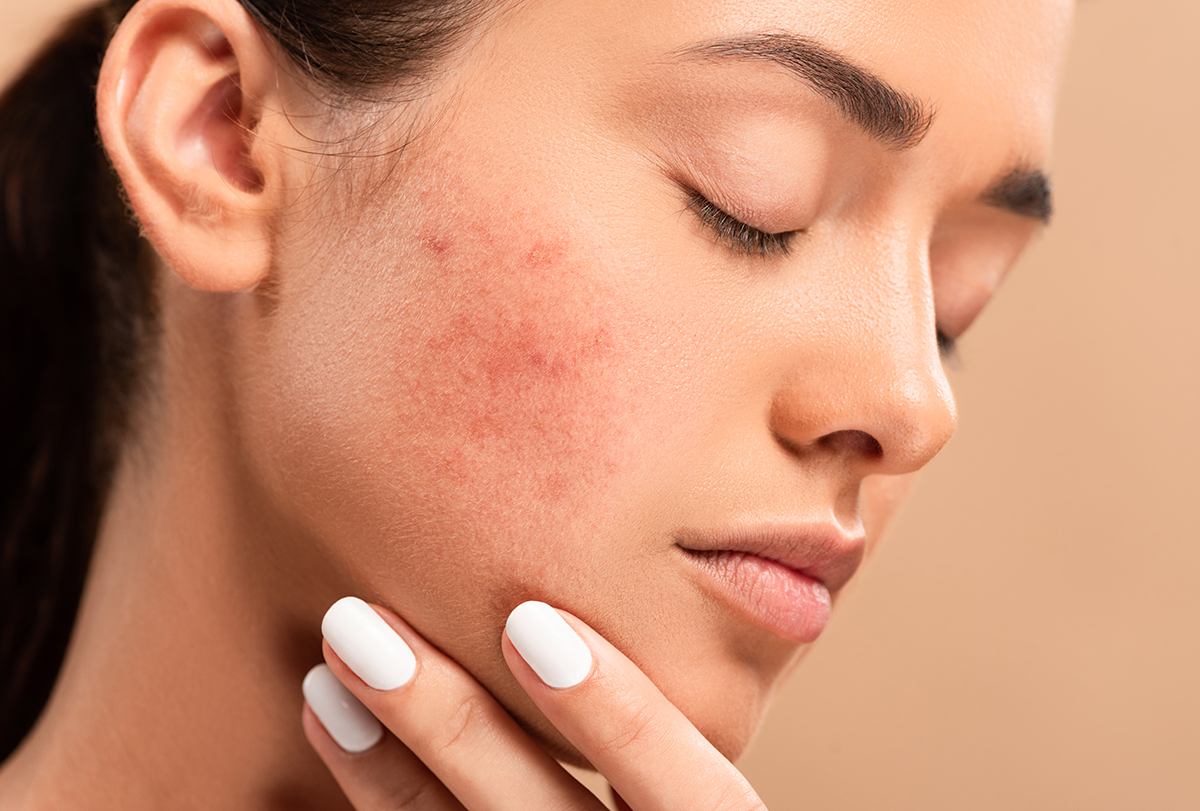
Thus, scab formation is an important part of the healing process as it allows the ruptured skin to repair itself properly.
While scab formation is a healthy sign of proper skin healing, it can be quite an eyesore if it appears on the face. This article will discuss quick and easy ways to get rid of scabs on the face without further damaging the skin.
Process of Scab Formation
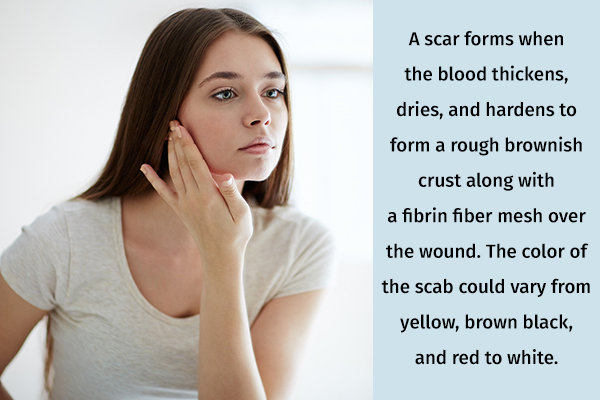
Human skin serves as a barrier between the body and the outside world. This protective shield is the foremost defense of the body against external irritants and germs.
A cut, scrape, or wound creates a tear in this superficial barrier, allowing entry to pathogens and other foreign substances that can trigger infection and illness. But your skin is a self-healing organ that has an innate mechanism to counter this breach as well.
When your skin ruptures, it starts to bleed, and then the clotting process kicks in. The blood thickens, dries, and hardens to form a rough brownish crust along with a fibrin fiber mesh over the wound known as a scab. The color of the scab could vary from, yellow, brown black, and red to white.
This crust forms a natural bandage over the broken skin to keep more blood or other bodily fluids from oozing out. At the same time, it prevents the entry of germs and other foreign bodies into the body through the open wound. (1)
Under the scab, new skin cells proliferate to repair the damaged tissue and blood vessels to facilitate proper wound healing. The scab becomes drier over time and sloughs off naturally within a week or two to reveal fresh skin underneath.
Common Conditions That Cause Scabs on the Face
Facial skin is thinner and more delicate than the skin covering the rest of the body. Hence, it tends to tear easily under trauma. Even squeezing, rubbing, or scratching the skin too forcefully can make it rupture, eventually leading to scab formation.
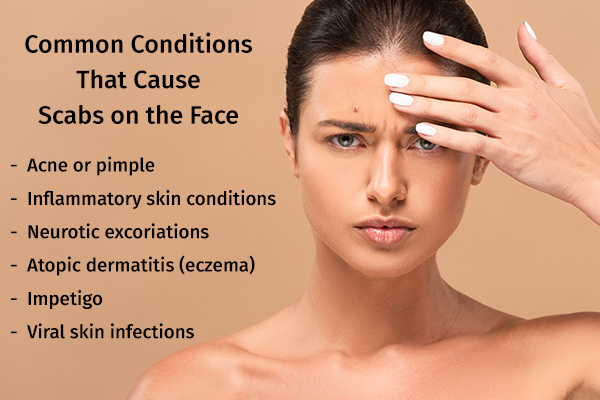
Some common skin conditions that are associated with scab formation include herpes, chickenpox, impetigo, burns, blisters, (2) and the following:
- Acne or pimple: When you pop a pimple, the skin ruptures and tends to scab over. (3)
- Inflammatory skin conditions: Psoriasis, (4) eczema, and dermatitis are characterized by underlying inflammation, which makes the affected skin extremely irritated, dry, and itchy. The same is the case with skin allergies. Incessant scratching of the itchy skin can lead to skin tearing and subsequent scab formation.
- Neurotic excoriations: This is a neurological disorder that triggers an uncontrollable urge to scratch, rub, or pick at normal skin. The repetitive trauma results in self-inflicted wounds that scab over.
- Atopic dermatitis (eczema): This clinical condition manifests as red, dry, and itchy skin, commonly seen in babies. It is another reason for scab formation on the face. It could also be due to irritants and allergens.
- Impetigo: This is a bacterial skin infection that can lead to red sores on your child’s face, leading to yellow-colored crusts. (5)
- Viral skin infections: Oral herpes, shingles, and chickenpox can cause lesions or rashes on your face that tend to scab over.
- Other trauma: Cuts, scrapes, and burns on the face tend to scab over as well.
Treatment for Scabs on the Face
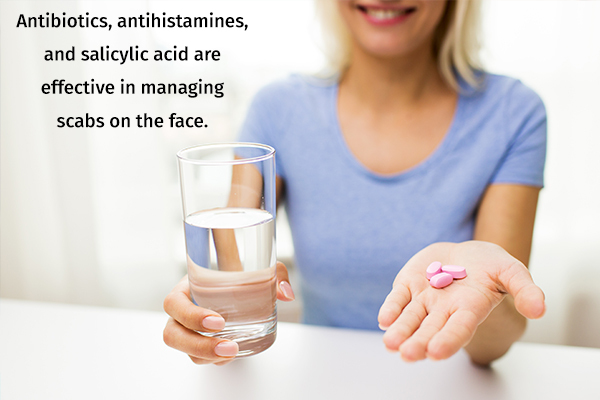
Here are effective ways to manage scabs on the face:
1. Let the scab heal on its own
The first and foremost rule of treating a scab is to leave it alone.
Scratching, pulling, or picking at the scab to remove the crust will further damage the new skin forming underneath it and set back the healing process. Ripping the scab by force can tear the underlying skin, which means the wound will take longer to heal.
Plus, this kind of trauma can lead to deep-tissue damage, which often leads to scar formation at the site of injury. Not just that, you can end up transferring germs to the wound through your contaminated fingers, which can lead to infection.
So, it is important that you let the scab heal on its own. The brownish crust will become drier over time and eventually fall off the skin as the new skin underneath is formed completely.
However, as the scab dries, it tends to itch, which is when you need to exercise maximum self-control and resist the urge to scratch.
2. Use topical and oral antibiotics
Doctors typically prescribe oral or topical antibiotics for treating scabs caused by bacterial skin infections.
3. Use antihistaminic medications
If the scabs are the result of an allergic reaction, the doctor will prescribe an antihistamine to curb the inflammatory immune response inside the body and reduce itching.
4. Apply salicylic acid
Salicylic acid is a skin-peeling agent that is available in the form of creams and gels. It can help accelerate the shedding of the damaged upper layer of skin so that fresh new skin can rise to the top. This action will also help with the faster removal of the scab.
When to See a Dermatologist
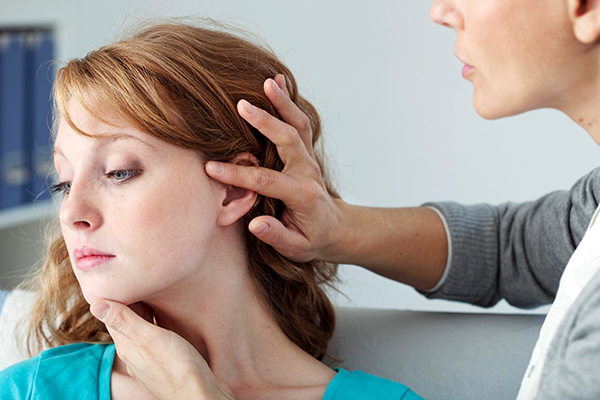
You generally don’t need any treatment for scabs as they heal on their own and fall off the skin within a week or two. But you should consult a dermatologist in the following cases:
- If the scab does not fall off naturally even after weeks
- If the scab starts to hurt, bleed, or ooze discharge, which can be a sign of infection
Most-Asked Questions About Scabs
How long does it take for a scab to heal?
The time it takes for a scab to fall off naturally depends on the depth of the wound it forms over. If the wound is superficial, it can take from 3–4 days to a week for the scab to heal, whereas those covering deeper wounds take a little longer.
Who could experience delayed skin healing?

The skin has the ability to repair and renew itself, but certain factors can slow down or impede this process.
Some of the prime culprits behind delayed skin healing are poor blood flow, preexisting skin infections, compromised immunity, diabetes, malnourishment, alcohol abuse, smoking or tobacco use, and medications such as corticosteroids and nonsteroidal anti-inflammatory drugs.
Final Word
Scab formation is your skin’s natural way of protecting itself and facilitating proper wound healing. The best way to get rid of a scab is to leave it be and let it heal naturally.
However, if the scab appears on the face, you may want to fast-track the healing process due to cosmetic concerns. In that case, you can consult your dermatologist for the appropriate treatment.
But come what may, don’t scratch or scrape the scab as it will not only undo the skin repair but also deepen the tissue damage, which may lead to infection and scarring at the wound site.
- Was this article helpful?
- YES, THANKS!NOT REALLY


